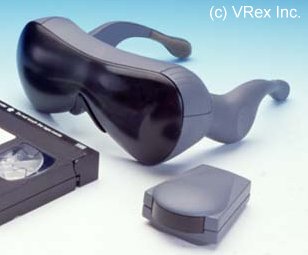
3D-Video Playback Equipment |

3D-Video Playback Equipment |
TV-Shutterglasses
DVD
Laserdisk
100/120
Hz TV
Digital
Fake-3D Devices
Pulfrich
Anaglyph
TV
Last update: Nov. 3, 2001
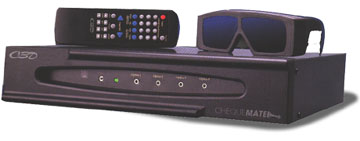 |
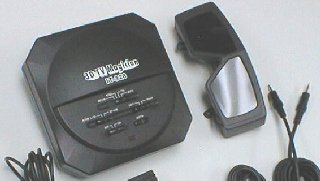 |
 |
In order to watch Stereo-3D Shutter-VHS video tapes, you'll need
some shutterglasses with video/tv-pass-through controller.
Opposed to computer-shutterglasses there are no compatibility
issues apart from the different TV systems (NTSC, PAL), but this problem
isn't stereo-specific, it applies to standard videos as well.
Most TV-Shutterglasses should work with any TV system, but not on
100/120 Hz TV sets and PC-TV-cards!
|
(NTSC/PAL/SECAM) |
Most TV-shutterglasses support NTSC and PAL, but you should ask the
vendor for compatibility with your TV-standard!
|
|
|

wired & wireless available |
(3DTV offers a wide range of TV-controllers and glasses.) read the review |

wireless |
Nu-Shades Freedom WearTM ================= i-3D Video Viewing System (NTSC-only?) ================= read the review of the PC version (H3D) |
|
wireless |
Another I's (TV-version) |

wireless |
read my review of the PC version |

wired |
|

wired |
The controller has 3.5mm and VESA-DIN3 jacks. read my review |

wired |
Virtual Max System (also distributed as "High-Tech 3D Glasses&Video") Adult oriented! (couldn't find any "official" site, offered all over the web on adult sites, prices vary) reviews another review warranty hookup Vidmax movie list |

wireless |
|

wired |
Controller |
|
|
|

wireless, 120 Hz |
coming soon |

wired |
|

wired |
|

wireless, 100 Hz |
|
There is no difference in 3D-quality between analogue
and digital systems when used with real stereo 3D-video-tapes. The digital
functions are used for other purposes.
Read my comments on the digital devices.
DVD
Slingshot just released several
DVD's in frame sequential stereo3D format for viewing with standard 60
Hz. NTSC-TV's and TV-shutterglasses.
They also offer a bundle with 3 titles complete with shutterglasses.
Neotek is set to release several
3D movies for Shutterglasses on DVD for playback on
the PC. They will use split-screen format and their sync-doubling technology
which means it won't work with all those other TV or PC glasses out there.
There's already a MPEG-2/DVD authoring software package called TriDVD
available from 3DTV Corp.
There are some IMAX movies already available on DVD. All flat!!!
Some early 3D-DVD videos already available use the inferior Pulfrich
system.
Laserdisc
Several years ago (maybe in the late 80's) I saw a short segment on
TV where they showed a LaserDisc-Player with Shutterglasses and some 3D-titles,
like Jaws3-3D. Don't know if this was just a prototype or if any of those
got on the market.
Shutterglasses
Since Shutterglasses are superior to Anaglyph and in some cases to Polarization those old movies could look better at home than ever before. I saw "Metalstorm" and "Captain Eo" with polarization glasses and "It came from outer space" with anaglyph glasses on the big screen. The ghosting was IMHO worse than with shutters! That's why IMAX uses shutters in some theatres. (If you're lucky. IMAX3D seems to use polarization more and more.) BTW I think shutter supported 3D images on the big screen are not only of higher resolution, but clearer than on a tube. The movie screen just blanks out after each frame. A CRT (cathode ray tube) monitor just can't do this. The monitor tube suffers from "persistance" which can lead to crosstalk (ghost images) when used with shutters. On the other hand the persistance is needed to reduce flicker.
Flop
Until now all attempts to introduce shutter technology to the TV/Video
market flopped. The most prominent example might be the Sega LC-Shutterglasses
for the Sega Master System. What's the problem? Well, the current
TV systems deliver 50Hz (PAL) or 60Hz (NTSC) interlaced. That's
25 or 30 Hz for each eye when combined with shutterglasses. That's not
enough. Headaches are almost guaranteed. The room has to be completely
dark as well.
There are ingreasingly popular (at least in Europe) TV sets which deliver 100Hz (PAL) through digital buffering. I never tried it but I'm convinced that the available Shutter-systems won't work with this technology. The modern 100Hz TVs analyse the images constantly for motion blurr and switch between modes. For the technically advanced: One frame on TV consists of two half-frames referred to as A and B. In PAL you get 25 frames a second consisting of 50 half frames. To double the frequency you could digitally store A and B and just repeat them. The result is an AB AB sequence. If there's movement and the image was filmed with a video camera (instead of a movie camera) you'll get motion blurr between the half-frames resulting in irritating digital artefacts. So in case the 100Hz TV recognizes movement it switches to AA BB repeat sequence. That switching should screw up any alternate line 3D video. It wouldn't work anyway, because you'd need the 100 Hz to sync the glasses, but those 100 Hz are only available IN the TV-set. The 100 Hz sync isn't available from the video in or out connector. There is a 100 Hz TV with 3D built in however, the german TMP/S3R Live-Eyes-3D-TV-Set. Read below.
|
|
C-3D

As you might have noticed in the past I'm not the one who easily flamespeople, but maybe it's about time. Here's a little taster from the C-3D pages:
"C-3D can be used to enhance network television, cable, video games, video cassettes, satellite programs, or any other signal source that can be played on a normal television! Imagine watching your favorite movie - Jurassic Park, Star Wars, Indiana Jones - in 3-D!"
Those guys developed a digital shutterglasses
controller/video converter which can generate an artificial
parallax in any video signal. So the FLAT (!!!) image seems to be in the
TV set rather than on it. Big deal. Maybe they're using some other
tricks, like time-parallax (Pulfrich-principle) to enhance the effect a
bit. I don't know. They're talking about digital enhancement and stuff...
bla bla bla. The price for the controller, 2 shutterglasses
and a demo-video : $ 599. Bon Appétit. The system
can be used to watch real stereoscopic videos too, but you can do this
with a $ 100 system (like VR-Surfer, H3D, 3DTV Theatre) or a homebrew
controller as well.
This Pseudo-3D, they call it "Mystic 3-D"- mode would, if successful,
further erode the term "3D" in the perception of the public.
I know it's unfair to criticize a product without a hands-on test,
but I know this isn't 3D. Maybe in the far future after 3D became
a standard in the movie business they'll do Stereo versions of classics,
like Star Wars, by using the latest computer technology, just like they
colorize b/w material today. But even with the most advanced technology
it'll cost millions of $$$ and hundreds of man-years worth of handywork
to transform one 2D feature into 3D. Each object has to be painfully cut
out and tampered with. That's how many Viewmaster reels were done out of
2D material. The result isn't always satisfying. - Man, I'm talking to
much.
The good news is that C-3D
plans to issue lots of real stereo movies on video, starting early '98.
Their major marketing point however seems to be the use of normal 2D video
sources.
3DTV Magician
(don't confuse with this other company called 3DTV Corp.)

There's another product which claims to be able to get Stereo3D out
of any normal video signal. The Ideatech IT-328
3DTV Magician. Well, stereoscopy is like resolution or color all about
information. A normal movie or TV broadcast doesn't contain this information,
apart from maybe a bit of time-parallax in horizontally moving objects.
To see this time-parallax 3D some $1 cardboard glasses with one lighter
and one darker glass is sufficient. Maybe the effect is made stronger here
by a digital prolonged time lag between the frames? As usual the system
can be used to watch real stereoscopic video material, but you might
get this ability cheaper somewhere else. The Magician is also able to
digitally convert between the TV-standards PAL/NTSC/SECAM. This can
be used to copy a video-tape from one system to the other. That's nice.
I've also heard the Magician isn't that expensive, so it's an interestig
product afterall. (Thanks to Ignatius
Lam for the info.)
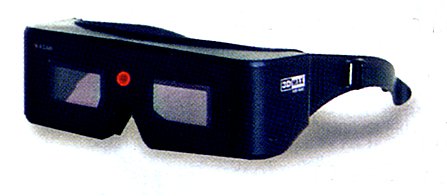
A german TV-manufacturer (located in Bayreuth) integrated a technology similar to C-3D and Magician into a luxury TV-Set. The "TMP/S3R Live-Eyes-3D-TV-Set" has a large 82cm screen, digital technology for what I call "Pseudo- or Fake-3D", a Shutterglasses-IR-emitter and all the features you expect from a top of the line TV. The glasses? Kasan 3D-Max wireless!!! The advantage compared to external digital-boxes for standard TV-sets? The increased refresh rate of 100 Hz (PAL)! The price? DM 9000,- = $ 5000. I think there are alternate uses for that amount of dough. (Source: DM magazine 12/97, page 98.)
|
|

Pulfrich glasses as used on broadcast-TV
There's another system used only on broadcast TV and video. It
utilizes "one sided sunglasses". The darkened eye reacts slower to optical
stimuli. This effect is called Pulfrich-effect in honor of the german physicist
Carl Pulfrich (1858-1927). It's based on a time-parallax in horizontally
moving objects. Well it's good for a gag, but nothing more. The object
or the camera has to move around horizontally (!) all the time to produce
a 3D effect. The parallax is determined by the speed of movement. In case
the movement stops the image turns 2D.
|
|
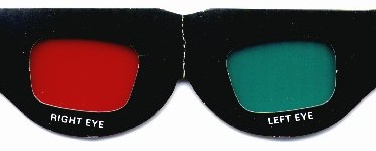
BTW there was an analogue Pseudo-3D system using anaglyph glasses
on the german market. The circuit was built into the TV-set. It played
around with the timing of the "red" electron beam. About 15 years ago this
was a big thing over here - for a few days :-) .
I saw some true 3D anaglyph stuff on german TV too - some demos and
Creature of the Black Lagoon I think.
There should be some anaglyph video tapes on the market, but I couldn't
find anything yet.
Dimension3
- is a good link for infos on broadcast TV 3D stuff. It's a commercial
site though.
Brand and product names are trademarks or registered trademarks of their
respective holders.
Some images are taken from the official product websites.
The author can not guarantee the accuracy of the information given
on this page.
Christoph Bungert, Germany .